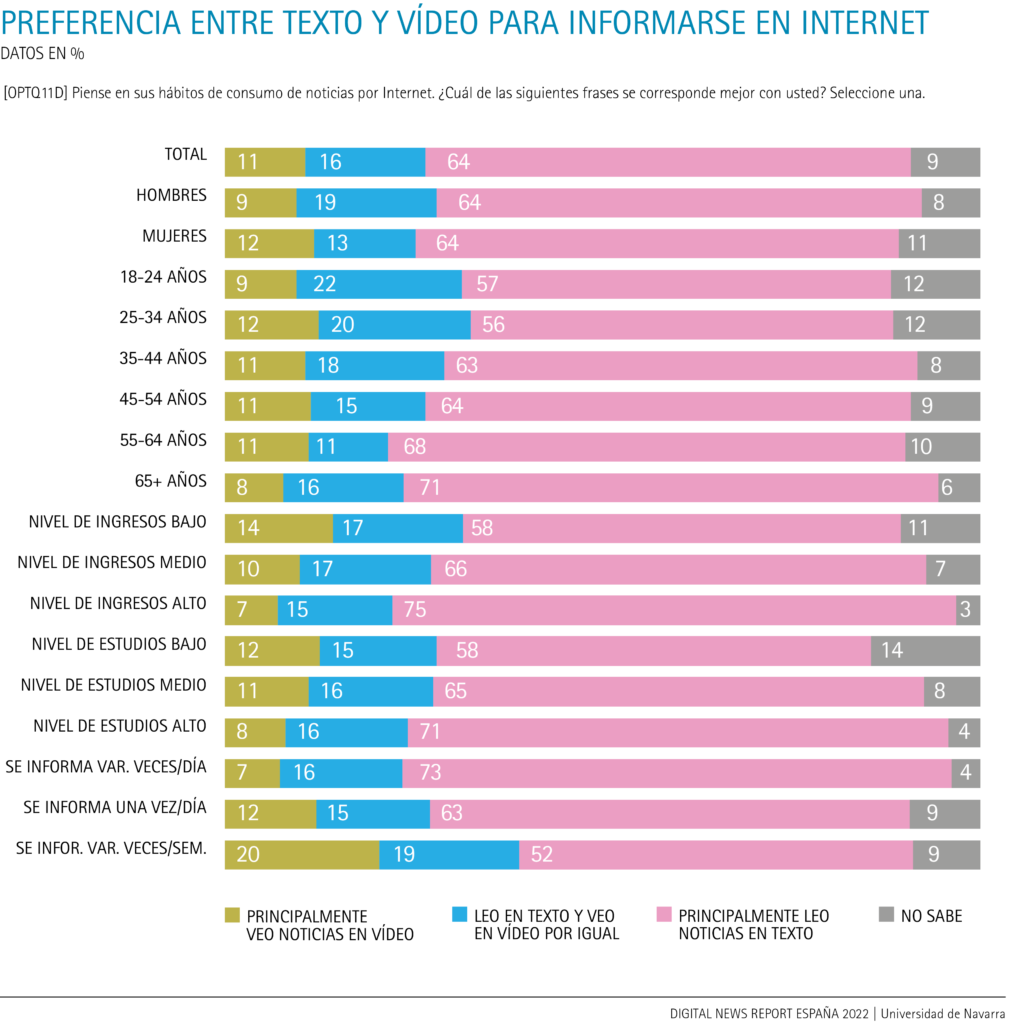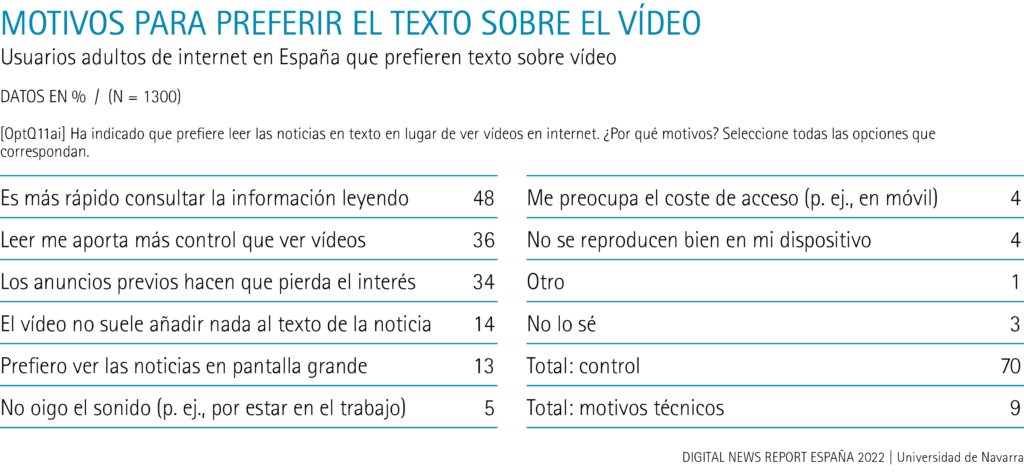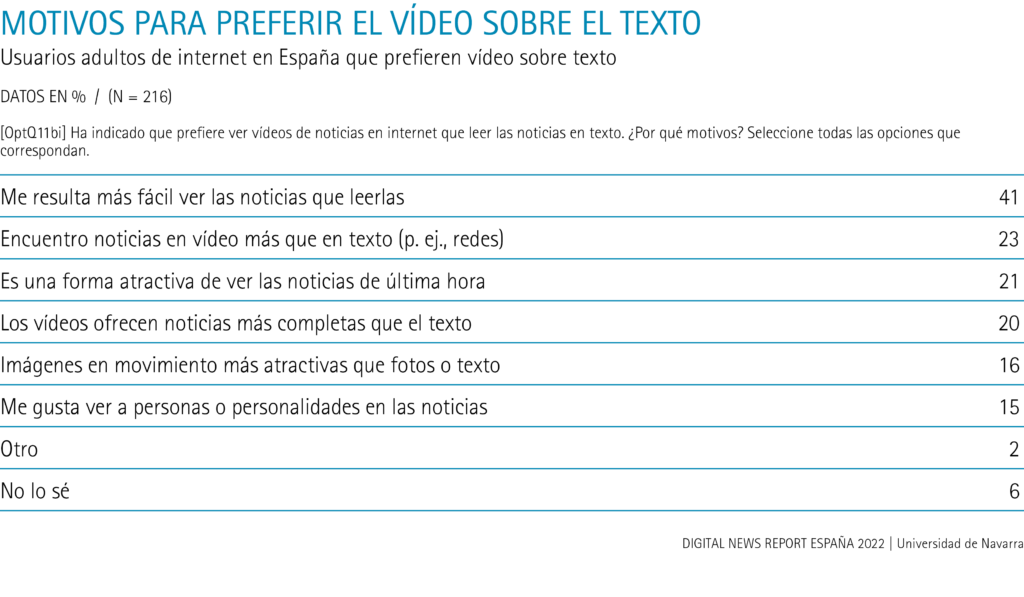-
Eleven percent of Internet users primarily watch news on video, most issue among people with lower incomes and programs of study, and another 16% read and watch video equally.
-
People who prefer text argue that it gives them greater control over the information experience (70%); in particular, they cite speed (48%).
-
The main values of video among those who choose it are ease of consumption (41%) and attractiveness (34%). Only 9% reject video for technical reasons.
In this edition, the Reuters Institute Digital News Report global study revisits an old question that pits the enquiry of news and current affairs in video against consumption in text format, even though this may not be an entirely natural distinction in the eyes of users. Written news continues to predominate on the Internet, but the proportion of users who get their news from video has increased in recent years: 27% of users now get their news from video at least as much as from text, and three out of ten adults under 45 years of age do so.

53% of internet users consume some news video, and 11% do so as a priority over reading, when in 2018, the last time respondents were asked, this group represented 7% of internet information users. Video finds more acceptance among young people; notably, people who watch videos and read news more or less equally are already 22% among 18-24 year olds, and 20% among 25-34 year olds, whereas in 2018 they were 17% and 16%, respectively.
Those who primarily read news in text have gone from accounting for nearly eight in ten in 2016, and 71% in 2018, to accounting for seven points less, 64%, in 2022. Among adults under 35, text is preferred over video by 56%, and the profile most consuming video over text is a male aged 25-34.
There are large differences in video preference according to household income level (14% at the lowest level, versus 7% at the highest) and smaller variations from agreement with the level of programs of study (12% among people with lower formal Education , 11% at the middle level and 8% at the highest).
A crucial distinguishing factor in the preference for text or video for information is the frequency of news consumption. Among those who get their news several times a day, just 7% prefer video over text, while this option accounts for 12% of those who check the news once a day, and no less than 20% of the minority who get their news several times a week, but not every day. In addition, text and video are consumed equally by 16%, 15% and 20%, respectively.
Reasons for preferring text
The majority of users who say they prefer text argue that it is faster to consult information by reading (48%), that reading gives them more understanding (36%), or that previous ads make them lose interest (34%); at summary, 70% give different reasons related to the control of the information experience.
Far fewer justify their preference for written news over audiovisual news on the Internet because video does not usually add anything to the text of the news (14%) or because they are concerned about not hearing the sound (5%), the cost of access by data mobiles (4%) or playback problems on their device (4%).

Technical reasons are much more prevalent among younger users, with 22% of those aged 18 to 24 preferring text over video, and between 11% and 12% in the next two age groups, 25 to 34 and 35 to 44. On the other hand, they are barely relevant for 5% of users aged 45 and over. The highest rejection of pre-roll ads is among 25-34 year olds, with 43% of people citing it as a reason why they prefer to read news in text rather than watch videos about it.
Reasons for preferring video
Among the minority who prefer video over text, 41% find it easier to watch news than to read it; 23% find more news in video than in text, for example, when enquiry their social networks; 21% find video an engaging way to watch breaking news; and 20% rate video as providing more comprehensive news than text. In addition, 16% find moving images more appealing than photos or text, and 15% like to see people or personalities in the news.

Videos are enquiry easier than text for 53% of people over 45 who prefer them, compared to only 27% of people under 45 who make this argument. Nearly half of women who prefer watching videos to reading news consider it an easier format to consume (49%, compared to 32% of men who acknowledge this).
Among those who prefer this format, the arguments related to the attractiveness of the format are shared by 42% of men compared to 27% of women, and by 42% of people under 45 years of age compared to 27% of people over 45 years of age. Overall, the arguments related to the attractiveness of video convince one out of three users (34%).